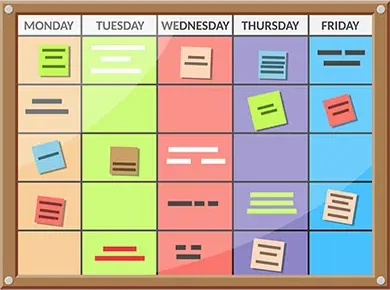Do It Tomorrow is a new approach to time management and includes a few radical new ideas. Notions like “closed list”, “the manana principle” or “will do” lists are used since it looks that just prioritizing tasks doesn’t seem to be enough to organize a schedule. Among the positive effects of this time management method, in addition to increased efficiency, are a decrease in the risk of task-overload and stress reduction.
How was created the Do it tomorrow
Do it tomorrow belongs to Mark Forster (born 24 November 1943), a British business coach specialized in time management and personal organization. The method was launched with the book Do It Tomorrow and Other Secrets of Time Management. This happened 6 years after the launch of another innovative time management method, namely Autofocus, along with the book Get Everything Done and Still Have Time to Play.
Do it tomorrow is a refined method, “a complete system that will enable almost anyone to complete one day’s work in one day”.
The basic principles of the Do it tomorrow
Do it tomorrow is based on several principles that form its foundation and which challenges some traditional practices in time management. The seven principles are:
- Have a clear vision of what you are trying to achieve. Define very narrowly what you are going to do and what you are not.
- One thing at a time. Devote your full attention to the task at hand
- Little and often. A little bit frequently rather than a large chunk of work infrequently
- Set Limits. Set a time limit for each task then take a break.
- Closed Lists. This will establish a boundary on your work.
- Reduce Random Factors. Avoid distractions.
- Commitment or Interest? You’ll get better results when committed.
Applying the Do it tomorrow
Do It Tomorrow has a “quick start guide” that includes 4 tasks. This guide is presented by the author before chapter 1 of his book Do It Tomorrow and Other Secrets of Time Management:
- Put all the work that you are behind on in backlog folders (email, paper, etc.) and put it where you can’t see it.
- Collect all your incoming work during the day and deal with it in one batch the following day. Group similar activities like email, paper, phone calls, and tasks. Aim to clear the lot every day.
- If anything is too urgent to leave it to the following day, write it down on a separate list and action it at a convenient time during the day. Never take even the simplest action without writing it down first.
- Spend some time on clearing the contents of the backlog folder(s) first thing every day. When you’ve finally cleared them, find something else you want to get sorted and start doing that first thing every day instead. If you follow this simple process you will be totally on top of new work by tomorrow and you will be well on your way to clearing your backlog.
Only a certain amount of work can be done in a day. Starting from this idea, planning for tomorrow the tasks that appear today, helps you to know from the beginning how much you have to accomplish the next day. If you are busy solving all the unexpected tasks, then the important and possibly planned things will remain unresolved.








2 comments
Amazingly! Amazingly!
Thanks!
Comments are closed.